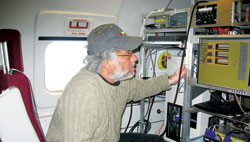Related Reading
Research Library
Learn More
Climatic Effects of Aerosols

Aerosols, tiny particles suspended in the air, affect the Earth's energy balance by absorbing or reflecting solar radiation. This is called the aerosol direct effect. Aerosols also have an indirect effect by influencing cloud properties, such as lifetime, height, and the number and size of droplets. Clouds with fewer but larger droplets reflect less solar radiation (low albedo) while those with high aerosol concentrations reflect up to 90 percent of radiation back into space (high albedo). Dark aerosols from industry can settle on Arctic ice, which normally reflects sunlight, and accelerate melting by absorbing sunlight. Los Alamos researchers are analyzing aerosols using airborne and satellite techniques.
 Click to enlarge
Click to enlarge
The Cloudy Science of Aerosols
Tiny Airborne Particles Have A Big Effect
Clouds of Particles
Anthony Mancino
Every child, watching white fleecy shapes shift in the sky, naturally wonders where clouds come from. Most will probably learn that clouds form when water evaporates from lakes, rivers, and oceans and condenses into droplets that eventually fall as rain. Though mostly correct, that explanation is missing an important piece. Cloud droplets need airborne particles, called "aerosols," around which to condense. These particles are hurled into the sky naturally from dust storms, volcanoes, sea spray, and fires, but many come from human industrial and agricultural activities. That's right; those graceful, pristine puffs of cotton candy are also made of pollution and dirt that humans and the planet spew into the atmosphere.
Aerosols are tiny, ranging from 1/1000th of a micron to 100s of microns—anywhere between the size of a virus and a grain of sand. The period at the end of this sentence, at about 500 microns, would be an extremely large aerosol. Though miniscule, aerosols have an enormous effect on global climate by directly reflecting or absorbing solar radiation. Aerosols also indirectly affect the climate because they influence the size and abundance of cloud droplets, which in turn determine how much sunlight a cloud reflects and how much rain it produces. (See "Learn More.")
Human-generated aerosols alter global climate, as do their better-known stepsisters, the greenhouse gases, but aerosols' effects are more complicated—so complicated that the Intergovernmental Panel on Climate Change (IPCC) declared them the greatest source of uncertainty in predicting climate change. And that's a big problem.
Just as a Florida homeowner relies on the local weather forecast to know if it's time to board up the windows, policy makers around the world need long-term, global-climate predictions to plan appropriate responses. Current climate models predict that by the end of this century there will be a temperature increase of 1.2ºC to 4.4ºC—a range far too wide to be a useful prediction. Aerosols are the unknown quantity.
To reduce the uncertainty, climate scientists must do two things: first, identify a precise numerical value for the effect aerosols have on the planet's energy budget. The Earth maintains a balance between incoming solar radiation and amounts reflected back into space or absorbed and re-radiated as infrared. Changes in the balance are known as "radiative forcing." Earth's preindustrial equilibrium is the baseline, and scientists need to accurately measure changes to it caused by human-generated aerosols. Second, scientists must gain a better understanding of the interactions between aerosols and clouds to accurately represent them in predictive models. To achieve these goals, researchers at Los Alamos National Laboratory are using the Laboratory's unparalleled computing power and advanced tools for gathering and interpreting atmospheric data.
 Manvendra Dubey analyzes samples using a photoscoustic instrument.
Manvendra Dubey analyzes samples using a photoscoustic instrument.
 Click to enlarge
Click to enlarge






